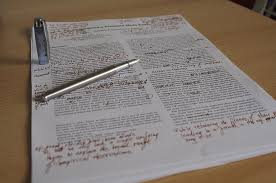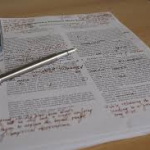
All You Need to Know About Copy Editing
 All You Need to Know About Copy Editing
All You Need to Know About Copy Editing
Reposted with permission from Write Divas
It’s probably crazy that I’m excited to write about copy editing, but there you have it. I am a total editing geek, and I will mentally edit Facebook posts—my own as well as others’—tweets, blogs articles, books I’m reading… you get the point. I take my editing very personally, and I put everything I have into each manuscript I work on. I have been known to call fellow editors in horror after finding a typo in a book I’ve edited—yes, there’s not an editor out there who’s perfect. And my fellow Divas have had to remind me to not mentally edit a book that we’d bid to edit but didn’t get, even though I really, really wanted to work on it.
So, yeah. I love editing, and today’s discussion is my favorite type of edit: copy editing. What can a copy editor do for you? What can a copy editor do for your manuscript?
This is by no means all inclusive; there are plenty of other things involved in copy editing. It is also not the exact list that another copy editor will give you because if I’ve learned one thing as a professional editor, it’s that the lines between different types of edits are wavy and move all the time. And editors working for a publishing house edit differently than independent editors who work directly for the author.
But first, let’s talk about the basics of copy editing. Copy editing is primarily the mechanical or technical side of editing—the wrong versus right, rule-oriented, less subjective editing that involves grammar, punctuation, spelling and word usage to an extent, consistency, clarity, and readability.
Proper grammar revolves around constructing clear, readable sentences using words, phrases, and clauses. The rules of grammar include using all classes of words correctly, and there really are too many to list. However, some of the commonly found copy editing mistakes have to do with noun/verb agreement, using the right tense, pronoun agreement, adjectival phrases, and participial phrases.
Copy editing for grammar also means knowing there’s a difference between narrative and dialogue. While proper grammar in narrative is almost always the best choice, being proper in dialogue may not be. If you think about it, people don’t always speak in grammatically correct sentences, so to write dialogue that way can be tedious to read and sounds stuffy and pretentious to listen to.
Punctuation is what I spend most of my copy editing time on. Just as grammar has defined rules, so does punctuation. However, the rules of punctuation sometimes seem more like guidelines; some of the rules are adhered to strictly, such as punctuation around dialogue. Very rarely does any group come along and announce they are changing the way this is done. But guidelines regarding other forms of punctuation have become almost fluid to some, which frustrates the rule-followers among us. Banishing the serial comma? The horror! Not separating an opening clause? Gasp! I’m looking at you, comma minimalists!
Correct punctuation means knowing when to use an em dash or when to use a comma, how to punctuate dialogue properly, and how to nestle a quote inside a quote inside a quote. Correct punctuation can also help when the family turns into cannibals.
But editing is also about readability, so even I have been known to cut a ‘necessary’ comma or two from a sentence to make it less choppy and easier to read. But I tend to make that the exception, not the rule.
Spelling /word usage is one of my favorite parts of copy editing because that’s where we have the most fun—at least that’s where I have the most fun… with homophones. Homophone confusion is the cause of most spelling/word usage errors in any manuscripts. Whether it’s something simple, like a their/they’re/there issue, or something a little more tricky—like free rein. Based on the amount of times I’ve seen rein misspelled, it may not be common knowledge that to allow someone free rein is derived from a rider loosening the reins, thereby giving his horse free rein to move about how and where it chooses. To allow someone free rein does not derive from sovereign rule and is not spelled reign. And the age of auto correct has given us sound-alike gems like candle operainstead of candelabra and higher archery instead of hierarchy. Come on… you giggled, too.
Word usage is really only a copy editing issue to the extent that the editor considers the word choice incorrect, inappropriate for the situation, or repetitive. When editing, I’m not likely to flag a word I think is too flowery for my tastes or not flowery enough. But if a sentence obviously needs the word angry instead of the word happy, I’ll note that for the author. Similarly, if I notice multiple uses of a word in the prior sentence, paragraph, or page, I’ll leave a note for the author with a suggestion for a new word or two.
Removing redundancy and repetition are part of enhancing readability, and streamlining dialogue tags is often included in this. If it’s clear who’s speaking in a sentence, tags like “she said” or “he cried” may be noted for deletion. Creative dialogue tags are the bane of many an editor who shudders at tags like “she apologized” and “he commiserated.” Not only are tags like these creative in the extreme—apologized is not a way of speaking in the same way saying, yelling, or whispering are—but they are almost always redundant when attached to the words of apology they surround.
Technical consistency is also part of the copy editing I do. So I make sure all your ellipses are formatted the same, all your em dashes have no spaces, and all your commas are used consistently. I also make sure that the indents aren’t tabs, that your chapter headings are consistent, and that you don’t have extra spaces just hanging around for fun. Those suckers are sneaky—you’d be shocked to see how many there are in the average manuscript. Also part of this consistency are special words or special spellings that are used specifically in your manuscript. Every manuscript gets its own style sheet where we keep track of special spellings and words to make sure that each use in yours is consistent.
Since copy editing happens after the developmental or substantive editing is done, I also check for story line inconsistencies or errors that may have sneaked through. Things like the details about characters or names of places as well as timeline paradoxes and factual errors are important to note to the author so that these things don’t end up in the final product.
As I mentioned at the beginning, this list is not all-encompassing. There are so many more exciting copy editing details to share, but I think I’ll save them for another article.